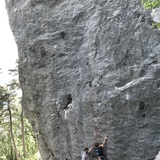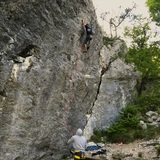🚶🏻♂️⏱15 '/ 0,8 km - ⏱ W/S/E - ⇡ 435 mt
🇬🇧ENG
Huge boulder in the shape of a parallelepiped on which it is possible to climb on all its sides, on about twenty routes, with a prevalence of medium / high difficulty.
Its walls are almost all overhanging, with a maximum height that does not exceed 15m. The result is a boulder-like style of climbing, which requires a lot of strength and endurance in the fingers.
Thanks to its various exposures, it is possible to climb it almost all year round (the presence of breezes and trees make it practicable even in summer), but the best time is spring and autumn.
🇮🇹 ITA
Enorme masso a forma di parallelepipedo su cui è possibile scalare su tutti i suoi lati, su una ventina di itinerari, con prevalenza di difficoltà medio/alta.
Le sue pareti sono quasi tutte strapiombanti, con altezza massima che non supera i 15m. Ne consegue uno stile di arrampicata boulderoso, che richiede molta forza e resistenza nelle dita.
Grazie alle sue diverse esposizioni, è possibile scalarci quasi tutto l’anno (la presenza di brezza ed alberi lo rendono praticabile anche d’estate), ma il periodo migliore è quello primaverile ed autunnale.
🇬🇧 ENG
The first itineraries on this boulder, renamed Masso Bonsai, were created by Giorgio Madrau and Gianni Cattaino, who in 1988 planted the first bolts giving life to two pitches, one subsequently unbolted, while the second ("Visionario '88") is still today scalable, which however, given their excessive difficulty for those times, make them desist from continuing with the tooling work.
It is only since 2002, by Gianni Cattaino, Attilio De Rove, Andrea Zancanaro and Alessandro Balestra, that the work resumed with the realization of about twenty pitches made in the following months.
🇮🇹 ITA
I primi itinerari su questo masso, ribattezzato Masso Bonsai, nascono ad opera di Giorgio Madrau e Gianni Cattaino, che nel 1988 piantano i primi spit dando vita a due tiri, uno successivamente schiodato, mentre il secondo (“Visionario ’88”) è tuttora scalabile, che però vista la loro eccessiva difficoltà per quei tempi fanno desistere dal proseguire nell’opera di attrezzaggio.
È solo a partire dal 2002, ad opera di Gianni Cattaino, Attilio De Rove, Andrea Zancanaro ed Alessandro Balestra, che riprendono i lavori con la realizzazione di una ventina di tiri realizzati nei successivi mesi.


